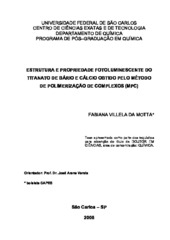| dc.contributor.author | Motta, Fabiana Villela da | |
| dc.date.accessioned | 2016-06-02T20:34:13Z | |
| dc.date.available | 2009-10-26 | |
| dc.date.available | 2016-06-02T20:34:13Z | |
| dc.date.issued | 2008-06-16 | |
| dc.identifier.citation | MOTTA, Fabiana Villela da. Structure and photoluminescent property of barium calcium titanate obtained by the complex polymerization method (CPM). 2008. 102 f. Tese (Doutorado em Ciências Exatas e da Terra) - Universidade Federal de São Carlos, São Carlos, 2008. | por |
| dc.identifier.uri | https://repositorio.ufscar.br/handle/ufscar/6130 | |
| dc.description.abstract | The synthesis and characterization of Ba1-xCaxTiO3 (BCT) for x = 5; 10; 15; 20; 40 e 80 % mol that crystallizes in a perovisquita structure were studied in this work. The BCT material was synthesized by CPM which allows obtaining structurally ordered and disordered powders. The effect of the calcium concentration was analyzed for the structurally ordered and disordered materials. The powders were crystallized at several temperatures ranging from 400 to 1200 °C for different times. The obtained materials were characterized by X-ray diffraction (XRD), Raman spectroscopy, differential scanning calorimetry (DSC) and X-ray Absorption Near Edge Structure (XANES) and photoluminescent emission (PL). These techniques allowed to observe the evolution of the phases as well as the structural disorder of the samples. XRD results indicated that up to 20 % mol of calcium, there is formation of a solid solution with Ca2+ ion occupying the Ba2+ site in the of the BaTiO3 crystalline network. It was verified that the BCT ordered phase was obtained after calcining at 600 °C by 2 h. The presence of an intermediate oxicarbonate barium phase in temperatures below of the tetragonal BCT crystallization. The luminescent property of structurally ordered and disordered BCT powders were studied at room temperature, using two excitation wavelengths: 350,7 nm and 488,0 nm. Structurally disordered BCT present broad PL band when excited by both of wavelengths. The powders annealed at 500 oC displays the most significant PL intensity. It was verified that with the increase of the calcium concentration, the maximum of the photoluminescent emission curve tends to laser wavelength energy. XANES spectra showed in the disordered powders the coexistence of sixfold and fivefold titanium coordination. A correlation between the coexistence of this two types of coordination for the titanium atoms and PL was proposed. | eng |
| dc.description.sponsorship | Financiadora de Estudos e Projetos | |
| dc.format | application/pdf | por |
| dc.language | por | por |
| dc.publisher | Universidade Federal de São Carlos | por |
| dc.rights | Acesso Aberto | por |
| dc.subject | Fotoluminescência | por |
| dc.subject | Titanato de bário e cálcio | por |
| dc.subject | Método de polimerização de complexos (MPC) | por |
| dc.title | Estrutura e propriedade fotoluminescente do titanato de
bário e cálcio obtido pelo método de polimerização de
complexos (MPC) | por |
| dc.title.alternative | Structure and photoluminescent property of barium calcium titanate obtained by the complex polymerization method (CPM) | eng |
| dc.type | Tese | por |
| dc.contributor.advisor1 | Varela, José Arana | |
| dc.contributor.advisor1Lattes | http://lattes.cnpq.br/1807399214239200 | por |
| dc.description.resumo | Neste trabalho estudado a síntese e caracterização do Ba1-xCaxTiO3 (BCT) para x = 5; 10; 15; 20; 40 e 80 % mol que se cristaliza numa estrutura perovisquita. O material BCT foi sintetizado pelo MPC, o que possibilitou obter pós estruturalmente desordenados e ordenados. A influência da concentração de cálcio foi analisada para os materiais estruturalmente ordenados e desordenados. Em adição, foi estudada a propriedade fotoluminescente. Os pós foram calcinados na faixa de temperatura entre 400 e 1200 °C por diferentes tempos. Os materiais obtidos foram caracterizados por difração de raios X (DRX), espectroscopia Raman, calorimetria exploratória diferencial (DSC), espectros de absorção de raios X na borda K do Titânio (XANES) e emissão fotoluminescente (FL). Essas técnicas possibilitaram avaliar a evolução das fases, bem como a desordem estrutural das amostras. Os resultados de DRX indicaram que, com até 20 % em mol de cálcio, há formação de uma solução sólida com os íons Ca2+ ocupando o sítio do Ba2+ na rede cristalina do BaTiO3. Foi observado que a fase ordenada de BCT é obtida quando o material é calcinado à 600 °C por 2 h. A presença de uma fase intermediária de oxicarbonato de bário foi identificada para os materiais calcinados em temperaturas inferiores à temperatura de cristalização. A propriedade luminescente do BCT foi estudada à temperatura ambiente, utilizando-se dois comprimentos de onda de excitação: 350,7 nm e 488,0 nm. O BCT desordenado estruturalmente apresentou emissão de banda larga quando excitado nos dois comprimentos de onda investigados. Uma alta intensidade fotoluminescente foi observada para o BCT tratado termicamente à 500 °C nas diferentes composições estudadas. Foi verificado que com o aumento da concentração de cálcio, o máximo da curva de emissão fotoluminescente tende a deslocar para comprimentos de onda de maior energia. Através das análises dos espectros de XANES foi verificada a existência de dois modos de coordenação diferentes para o titânio no BCT desordenado estruturalmente: hexacoordenados e pentacoordenado. Uma correlação entre a existência desses dois modos e a FL foi proposta. | por |
| dc.publisher.country | BR | por |
| dc.publisher.initials | UFSCar | por |
| dc.publisher.program | Programa de Pós-Graduação em Química - PPGQ | por |
| dc.subject.cnpq | CIENCIAS EXATAS E DA TERRA::QUIMICA | por |
| dc.contributor.authorlattes | http://lattes.cnpq.br/9918299069511517 | por |
